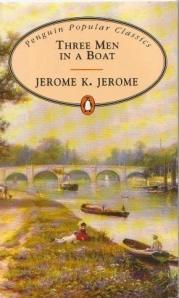
First published in 1889.
Three Men in a Boat tells the story of George, Harris, and J., who, accompanied by Montmorency (a misbehaving dog), take a boating trip up the Thames. Narrated in the first person by J., the novel is hilarious, touching, and occasionally profound. The humor ranges from dry wit to slapstick as J. recounts the trio's hapless efforts to row their way up the river.
Digression follows digression as the story unfolds. Passing Runnymede reminds J. of King John which reminds him of Henry VIII and Anne Boleyn, which prompts him to complain of the nuisance that young lovers make of themselves, which leads him to imagine coming upon Henry VIII and Anne Boleyn canoodling in a royal garden. During the course of the novel, J. turns his attention to the pleasures of food and idleness, to fish stories, to music and dogs and friendship and dozens of other topics.
Although Three Men in a Boat is a very funny comedy, the novel also offers a glimpse of British history as J. comments upon the various villages and towns they pass on their journey (the book was originally intended as a travel guide, a purpose that is hidden in its many levels). J. has his philosophical moments, as well; as they pass a monastery, he observes that the monks, vowed to silence and cloistered in their building so that they can hear the voice of God, are unable to hear that voice in the splashing water and in the wind whispering through the river grass. Indeed, some passages of this short novel are so beautifully written that I didn't want the excursion to come to an end.
Three Men in a Boat inspired the equally funny To Say Nothing of the Dog, a time travel story written by Connie Willis. Readers looking for a more modern version of Three Men in a Boat might want to try Willis' novel. I recommend reading them both for an interesting contrast of perspectives on boating the Thames, and for double the laughter.
RECOMMENDED